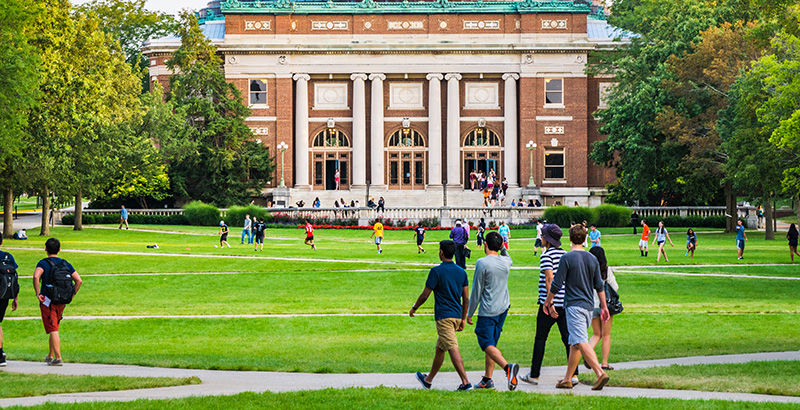Cook & Domenech: There’s Still Time to Reignite College Aspirations for the Class of 2021 by Using American Rescue Plan Funding

Get essential education news and commentary delivered straight to your inbox. Sign up here for The 74’s daily newsletter.
Last month, the U.S. Department of Education announced that K-12 schools will receive $122 billion under the American Rescue Plan’s Elementary and Secondary School Emergency Relief Fund. State and local educational agencies are now busy working out how best to spend the money, with the Biden administration encouraging schools to use the funds to not only support efforts to safely remain open, but to expand opportunity for students who need it most.
While schools are right to invest in safety precautions like better testing and improved air filtration, they should also get creative in how they spend American Rescue Plan dollars to address the historic learning challenges that have emerged over the last year. College readiness ranks among the most crucial.
By the fall semester, colleges and universities could very well be inching toward relative normalcy. But if steps are not taken now to repair the damage done to the transition between secondary and postsecondary schools, hundreds of thousands of students may not show up to college campuses across the country. College enrollment has sharply dropped during the pandemic, and applications for first-generation students and those from low-income backgrounds continue to decline. This is especially true among first-generation students and students from low-income families.
As of last month, completion of the Free Application for Federal Student Aid had fallen by 8.2 percent. That’s 150,000 fewer high school seniors completing the FAFSA than the class of 2020, a troubling portent for fall enrollment of students from low-income backgrounds. The number of first-generation students applying to college through the Common App is also down, by 3 percentage points, but 43 percent of first-generation students in a recent survey said they have increased the number of schools they are applying to due to the uncertainty around pandemic. Nearly half of those students say their college plans are changing because they find it too difficult to focus on their future — and for about one-third, it’s because they have been unable to connect to their school counselor for advice.
It’s an alarming dynamic. The most vulnerable students are facing personal, financial and academic challenges so daunting that they can barely envision a future beyond them. At the same time, they are struggling to access the help and guidance they now need more desperately than ever. But it’s not too late for schools to help the class of 2021 complete key college-going milestones, or to begin ensuring the classes of 2022, 2023 and 2024 are engaging in important college and career readiness activities.
Schools can use general Elementary and Secondary School Emergency Relief funds, as well as money reserved for addressing learning loss, to support students in transitioning from high school to postsecondary education. A special focus should be placed on outreach and engagement for first-generation college students and those from low-income backgrounds, whose college plans continue to be disproportionately impacted by COVID. American Rescue Plan funding can be used to promote FAFSA completion among families, invest in improving virtual advising for students and conduct surveys to understand students’ postsecondary aspirations or challenges in order to quickly connect them to proper supports.
Schools should also consider using the funds to expand programs that award college credit in high school, such as dual or concurrent enrollment programs, Advanced Placement, Cambridge International and International Baccalaureate. Advanced coursework of this type builds students’ confidence in their ability to succeed in college and demonstrates to colleges that they are ready for a postsecondary-level coursework. This summer will prove especially crucial to getting students back on track, and schools must use that time to support them in intentional ways.
Already, districts and schools around the country have used drop-in centers, advanced coursework, counselor summer hours and text message interventions to ensure their students’ fall matriculation for some time. But for many schools and districts, these approaches will be new. The stimulus funding, and the time we have this summer, present an important opportunity to implement these ideas to ensure student success.
Importantly, districts and schools will not have to go it alone. They can partner with a host of college access programs, community-based organizations, colleges and universities. National nonprofits such as College Advising Corps, College Possible and uAspire are all standing by to serve as valuable partners in this endeavor. Contracting with these or similar organizations will prove especially useful this summer, when many district employees are off from work, and can provide districts with more flexibility than if they were to hire permanent personnel.
At the same time, it’s essential that districts work to ensure the most effective of these activities are sustainable. State and local agencies should use the funding to establish strategies to not only address the immediate impact of COVID-19, but to develop the infrastructure necessary to continue these strategies beyond the pandemic.
It is more important than ever to think about students’ postsecondary outcomes. We must act quickly, but we can still reignite the college-going aspirations of the class of 2021. The funds now available to schools under American Rescue Plan can ensure states, districts and schools can help their students once again see a future beyond the pandemic.
Kim Cook is executive director of the National College Attainment Network. Dan Domenech is executive director of American Association of School Administrators.
Get stories like these delivered straight to your inbox. Sign up for The 74 Newsletter

;)